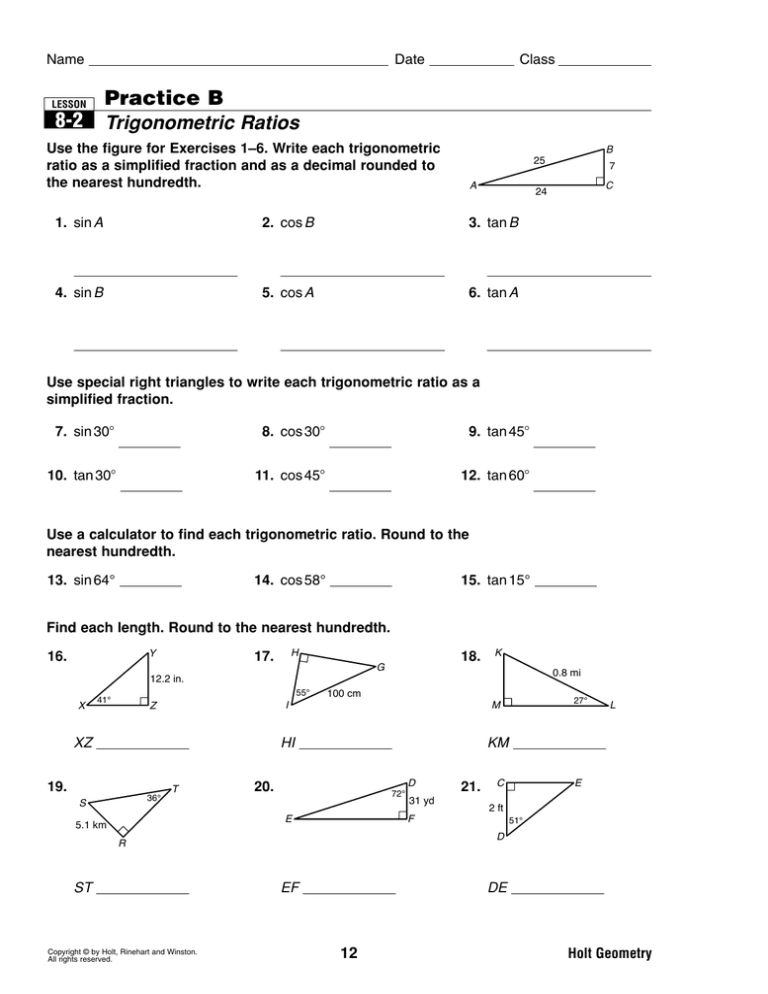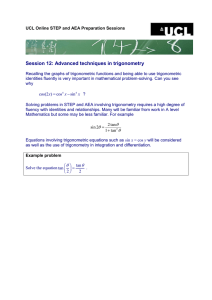
Name
Date
Class
Practice B
LESSON
8-2
Trigonometric Ratios
Use the figure for Exercises 1–6. Write each trigonometric
ratio as a simplified fraction and as a decimal rounded to
the nearest hundredth.
1. sin A
2. cos B
!
#
3. tan B
7 ; 0.28
___
7 ; 0.28
___
25
4. sin B
"
24 ; 3.43
___
7
25
5. cos A
6. tan A
24 ; 0.96
___
24 ; 0.96
___
25
7 ; 0.29
___
25
24
Use special right triangles to write each trigonometric ratio as a
simplified fraction.
1
__
7. sin 30
8. cos 30
2
3
___
3
10. tan 30
11. cos 45
3
___
2
2
___
2
9. tan 45
1
12. tan 60
3
Use a calculator to find each trigonometric ratio. Round to the
nearest hundredth.
0.90
13. sin 64°
14. cos 58°
0.53
15. tan 15°
0.27
Find each length. Round to the nearest hundredth.
9
16.
(
17.
18.
'
+
0.8 mi
12.2 in.
8
55°
41°
XZ
14.03 in.
19.
36°
3
100 cm
)
:
4
HI
57.36 cm
72°
8.68 km
Copyright © by Holt, Rinehart and Winston.
All rights reserved.
#
%
2 ft
&
51°
$
2
ST
31 yd
21.
,
0.36 mi
KM
$
20.
%
5.1 km
27°
-
EF
95.41 yd
12
DE
3.18 ft
Holt Geometry
Name
Date
Class
Name
Practice A
LESSON
8-2
8-2
In Exercises 1–3, fill in the blanks to complete each
definition. Then use side lengths from the figure to
complete the indicated trigonometric ratios.
�
�
�
�
Trigonometric Ratios
Use the figure for Exercises 1–6. Write each trigonometric
ratio as a simplified fraction and as a decimal rounded to
the nearest hundredth.
�
�
opposite
1. The sine (sin) of an angle is the ratio of the length of the leg
hypotenuse
.
the angle to the length of the
1. sin A
c
b
b
a
5. cos L
�
_3_ ; 0.60
10
�
6. tan M
_4_ ; 0.80
8. cos 30�
2
�
�3
___
3
10. tan 30�
6
11. cos 45�
�3
___
2
�
�2
___
2
9. tan 45�
1
12. tan 60�
�3
�
�
8
Use a calculator to find each trigonometric ratio. Round to the
nearest hundredth.
_4_ ; 1.33
5
5
24
�
_1_
7. sin 30�
Use the figure for Exercises 4–6. Write each trigonometric
ratio as a simplified fraction and as a decimal rounded to
the nearest hundredth.
7 ; 0.29
___
25
Use special right triangles to write each trigonometric ratio as a
simplified fraction.
b
tan B � ___
a
tan A � ___
24 ; 0.96
___
25
opposite
3. The tangent (tan) of an angle is the ratio of the length of the leg
adjacent
the angle to the length of the leg
to the angle.
7
6. tan A
24 ; 0.96
___
c
24 ; 3.43
___
5. cos A
a
cos B � ___
cos A � ___
c
3. tan B
25
4. sin B
adjacent
�
�
��
7 ; 0.28
___
25
2. The cosine (cos) of an angle is the ratio of the length of the leg
hypotenuse
to the angle to the length of the
.
�
��
�
2. cos B
7 ; 0.28
___
b
sin B � ___
a
sin A � ___
c
Class
Practice B
LESSON
Trigonometric Ratios
4. sin L
Date
3
0.90
13. sin 64°
14. cos 58°
0.53
0.27
15. tan 15°
Use a calculator to find each trigonometric ratio. Round to the nearest hundredth.
8. cos 47�
7. sin 33�
9. tan 81�
Find each length. Round to the nearest hundredth.
6.31
0.68
0.54
16.
�
62°
�
�
�
12.46 m
12.
�
5 ft
�
�
27°
13. The glide slope is the path a plane uses while it is landing on
a runway. The glide slope usually makes a 3� angle with the
ground. A plane is on the glide slope and is 1 mile (5280 feet)
from touchdown. Use the tangent ratio and a calculator to
find EF, the plane’s altitude, to the nearest foot.
11
Copyright © by Holt, Rinehart and Winston.
All rights reserved.
Name
8-2
�
�
����
Date
Class
Holt Geometry
4.
9 ft
78°
�
�
�
x � ___
1
� ____
�
�
x� 2
�2
�
2
�
___
�
2
13
Copyright © by Holt, Rinehart and Winston.
All rights reserved.
�
�
�
�
60°
45°
� ��
2
2�
�
45°
�
�
�
30°
�
� ��
3
�
�
�2 .
So sin 45� � ___
2
Write each trigonometric ratio as a fraction and as a decimal
rounded to the nearest hundredth.
1. sin K
�
2. cos H
15 � 0.88
___
�
17
8
�
15
�
15 � 0.88
___
17
17
3. cos K
4. tan H
8 � 0.47
___
8 � 0.53
___
17
15
Use a special right triangle to write each trigonometric ratio as a fraction.
6. tan 45�
5. cos 45�
�
�2
___
_1_ � 1
1
2
7. sin 60�
44.1 ft
8. tan 30�
�
�
�3
___
15 km
15.18 km
�
leg adjacent to �A
leg opposite �Q
sin 45� � sin Q � ______________
hypotenuse
75°
�3
___
2
6.9 cm
6.78 cm
�
�
You can use special right triangles to write trigonometric ratios as fractions.
Use the formula you developed in Exercise 5 to find the missing side length in
each triangle. Round to the nearest hundredth.
Copyright © by Holt, Rinehart and Winston.
All rights reserved.
leg opposite �A
�
leg opposite �A
tan A � ________________ � _4_ � 1.33
3
leg adjacent to �A
7 in.
44.1 ft
�
hypotenuse
leg adjacent to �A
cos A � ________________ � _3_ � 0.6
5
hypotenuse
2
2
2
2
2
2
2
gives b � 2bx � x � y � a . Substituting, b � 2bx � c � a .
x
_
_
But cos A � c, so x � c cos A. Another substitution gives
2
2
2
a � b � c � 2bc cos A.
4 km 85°
Holt Geometry
Trigonometric Ratios
2
2
2
It also shows that (b � x) � y � a . Expanding the latter equation
55°
Class
Trigonometric Ratios
12.05 in
8.
Date
Reteach
leg opposite �A
sin A � ______________ � _4_ � 0.8
5
hypotenuse
Possible answer: The Pythagorean Theorem shows that x 2 � y 2 � c 2.
7.
3.18 ft
DE
�
�
2
28.39 ft
7.7 cm
�
51°
95.41 yd
12
�
�
5. The law of cosines is a formula to find the length of the third side of
any triangle given the lengths of two sides and the measure of the
�
�
�
included angle. (Note: The law of cosines applies to any triangle,
but deriving it for an obtuse triangle requires more knowledge than
�
�����
�
you have learned so far.) In the figure, suppose the lengths b and c
�
and the measure of �A are known. Develop the law of cosines to find a.
Explain your answer. (Hint: Use the cosine function and the Pythagorean Theorem.)
6.
EF
Name
7.1 in.
2
18.66 m
�
2 ft
�
8.68 km
73°
7.6 m
2
31 yd
�
Copyright © by Holt, Rinehart and Winston.
All rights reserved.
Use the formula you developed in Exercise 1 to find the area of each triangle.
Round to the nearest hundredth.
43°
21.
�
72°
�
0.36 mi
KM
�
ST
8-2
11 ft
20.
�
27°
277 feet
Possible answer: Draw an altitude from �B and call its length h. Then
_
sin A � _h
c , so h � c sin A. The formula for the area of a triangle is
Area � _1_ base � height. Substitution gives Area � _1_ bc sin A.
2
2
35°
57.36 cm
�
LESSON
3.
HI
5.1 km
Trigonometric Ratios
7.2 m
36°
�
1. Given the lengths of two sides of a triangle and the measure of the
included angle, the area of the triangle can be found. In the figure,
suppose the lengths b and c and the measure of �A are known. Develop
a formula for finding the area. Explain your answer. (Hint: Draw an altitude.)
2.
0.8 mi
�
��
Practice C
LESSON
14.03 in.
�
2.55 feet
RS
�
100 cm
�
�
19.
�
�
19.70 mm
QP
�
55°
41°
XZ
38°
25 mm
11 m
BD
�
11.
18.
�
12.2 in.
Use a calculator and trigonometric ratios to find each length. Round to the
nearest hundredth.
10.
17.
�
3
22.83 ft
Holt Geometry
Copyright © by Holt, Rinehart and Winston.
All rights reserved.
53
14
Holt Geometry
Holt Geometry



